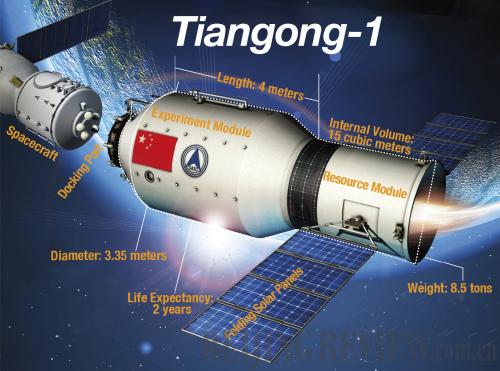|
 |
|
(CFP) |
In the medium term, China plans to launch Tiangong-2 and Tiangong-3 space modules around 2015, according to CNSA.
Tiangong-2 will primarily be used for Earth observation and Earth science research. It will also be home for research into aerospace medicine and other research programs.
Tiangong-3 will focus on research into regenerative environmental control and life support systems.
The final aim of China's space program is to establish a permanent space station.
"A spacecraft usually remains in space for a week or so. Therefore it has limited time to conduct scientific research," said Peking University Professor Jiao. "A functioning space station, however, can stay in orbit for a long time and scientists can run various experiments and develop space products."
In late April, the China Manned Space Engineering Office announced its plans to build a 60-ton space station and asked the public to help come up with a name and logo for the space station.
According to documents provided by the office, the space station will be composed of a core module and two others where experiments will be conducted.
The 18.1-meter-long core module, with a maximum diameter of 4.2 meters and a launch weight of 20-22 tons, will be launched first.
The two experiment modules will then blast off to dock with the core module. Each additional module will be 14.4 meters long, with the same maximum diameter and launch weight as the core module.
The office also said China will develop a cargo spaceship, with a launch weight of less than 13 tons, to transport supplies and lab facilities, including water, food, air and other necessities, to the space station.
At present, the Shenzhou spaceships will only be able to carry a 300-kg payload when three astronauts are on board. CNSA spokesman Wang said developing cargo supply technology would be among the tasks to be met in the 2011-15 period.
Meanwhile, scientists will also have to overcome the problem of recycling air and water within the space laboratory.
"When these problems have all been addressed, China will be ready to begin the launch and development of a true space station, said Qi.
As China prepares to make bold strides in space exploration, scientists and engineers are focusing their attention on safety.
"Space junk is a real threat and Chinese scientists have attached great importance to making space craft and space stations safe from debris," Qi said.
There is even a dedicated journal in China that covers research into space debris.
Given the breadth, depth and sophistication of China's existing research into space technology, it is inevitable that China's space program will reach parity with that of traditional leaders in the field, Russia and the United States, within the next decade. China's first space station is scheduled to be in operation by 2020, according to CNSA.
"The manned space program will lay the foundation for possible future missions, such as sending men to the Moon and Mars," Qi said.
China's Milestones in Space
October 8, 1956: An institute on missile and rocket research is established.
July 19, 1964: A rocket carrying albino rats is successfully launched.
April 1, 1968: An institute for spaceflight-oriented medical engineering is set up.
April 24, 1970: The Dong Fang Hong-1 scientific experimental satellite lifts off aboard a Long March rocket.
November 26, 1975: China's first recoverable satellite is launched.
September 7, 1988: A meteorological satellite, Feng Yun 1-A, is launched.
April 7, 1990: A Long March CZ 3 rocket sends the AsiaSat 1 communication satellite into orbit, marking the beginning of China's commercial launch service.
July 16, 1990: The Long March CZ 2-E cluster carrier rocket enters service, which is able to send a spacecraft into space.
November 20, 1999: The unmanned Shenzhou 1 spacecraft is launched.
January 10, 2001: The unmanned Shenzhou 2 enters space.
March 25, 2002: The unmanned Shenzhou 3 spacecraft is launched.
December 30, 2002: The unmanned Shenzhou 4 spacecraft is launched.
October 15, 2003: The Shenzhou 5 spacecraft blasts off into space, with Yang Liwei, the first Chinese astronaut aboard.
October 12, 2005: The Shenzhou 6 spacecraft is launched, sending two astronauts, Fei Junlong and Nie Haisheng, into space.
October 24, 2007: China's first unmanned lunar orbiter, Chang'e-1, lifts off.
September 25, 2008: The Shenzhou 7 spacecraft blasts off, sending Zhai Zhigang, Liu Boming and Jing Haipeng into space. Zhai completes China's first space walk on September 27, 2008.
October 1, 2010: Chang'e-2 lunar probe is lifted into space by a Long March 3 carrier rocket, marking the beginning of the second phase of China's lunar probe project.
September 29, 2011: China's first unmanned space module Tiangong-1, or Heavenly Palace-1, is launched from the Jiuquan Satellite Launch Center in Gansu Province.
(Source: Xinhua News Agency) | 